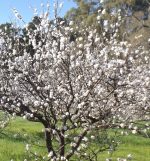 Native to central Asia, this deciduous small tree is a member of the rose family, Rosaceae, that also includes cherry, almond, and lady’s mantle. The trees grow 26-39′ tall and have a dense, spreading canopy of ovate leaves 2-3.5″ long, with toothed margins and 2 small glands at the base of the blade. In early spring before the leaves appear, white to pinkish flowers appear singly or in pairs. They have 5 petals and give way to fruits called drupes that are fleshy, yellow to orange tinted with red, each with a single seed enclosed in a hard ridged stony shell. Fruit production is very difficult because flower buds are very sensitive to early frost but the tree is well worth growing for its ornamental value. Evidence suggests that the apricot was domesticated in China by 1000 BC and was introduced into Greece by Alexander the Great. It is probably the “apple” of the Bible. The genus name, Prunus, comes from the Greek word προύνη meaning plum, a prominent member of this genus. The specific epithet, armeniaca, refers to Armenia, one of the geographic origins of the plant.
Native to central Asia, this deciduous small tree is a member of the rose family, Rosaceae, that also includes cherry, almond, and lady’s mantle. The trees grow 26-39′ tall and have a dense, spreading canopy of ovate leaves 2-3.5″ long, with toothed margins and 2 small glands at the base of the blade. In early spring before the leaves appear, white to pinkish flowers appear singly or in pairs. They have 5 petals and give way to fruits called drupes that are fleshy, yellow to orange tinted with red, each with a single seed enclosed in a hard ridged stony shell. Fruit production is very difficult because flower buds are very sensitive to early frost but the tree is well worth growing for its ornamental value. Evidence suggests that the apricot was domesticated in China by 1000 BC and was introduced into Greece by Alexander the Great. It is probably the “apple” of the Bible. The genus name, Prunus, comes from the Greek word προύνη meaning plum, a prominent member of this genus. The specific epithet, armeniaca, refers to Armenia, one of the geographic origins of the plant.
Type: Deciduous small tree
Outstanding Feature: Fruits, flowers
Form: Umbrella
Growth Rate: Moderate to rapid
Bloom: White to pink 5 petaled flowers singly or in pairs before the leaves appear in early spring
Size: 26-39′ H
Light: Full sun
Soil: Average, moderately moist, well-drained
Hardiness: Zones 5-8 (but may not produce fruit reliably because of damage to flower buds by early frost)
Care: Appply nitrogen in spring; prune annually and open the center; when fruiting thin to 3-4 fruits/cluster
Pests and Diseases: Apricots are susceptible damage by many insects, and fungal and bacterial diseases,
Propagation: Cuttings, budding, grafting
Outstanding Selections: Many varieties available including dwarfs and relatively hardy ones.